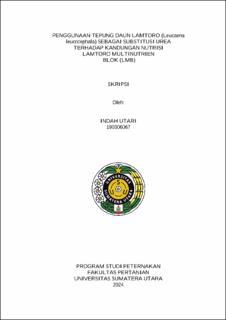| dc.description.abstract | This study was conducted to determine the effect of lamtoro leaf flour as a urea substitution on the nutritional content of lamtoro block minerals, namely moisture content, ash content, crude protein, crude fat, and crude fiber. This study used a Complete Randomized Design (RAL) with 5 treatments and 4 replicates. The next test used is the Duncan Multiple Range Test (DMRT) test. The treatment given was P0 (control: Urea 8% + TDL 0%); P1 ( Urea 6%+ TDL 10%); P2 (Urea 4%+ TDL 20%); P3 (Urea 2% + TDL 30%); P4 (Urea 0% + TDL 40%). The results showed that the difference in the administration of lamtoro leaf flour (TDL) produced a significant difference in moisture content, ash content, crude fat, crude protein, and crude fiber in the nutritional content of LMB (P>0.05). The results of the DMRT test showed that the highest moisture content was found in the P0 treatment (13.56%) and the lowest moisture content was found in the P3 treatment (11.46%). The highest ash rate was found in the P0 treatment (11.93%) and the lowest ash rate was found in the P3 treatment (6.72%). The highest crude fat was found in the P0 treatment (11.45%) and the lowest crude fat was found in the P2 treatment (6.68). The highest crude protein was found in the P0 treatment (21.30%) and the lowest crude protein was found in the P4 treatment (10.61%). The highest crude fiber was found in the P4 treatment (21.30%) and the lowest crude fiber was found in the P0 treatment (14.45%). Based on the results of the study, the LMB with the best nutritional content in this study is P1 (Urea 6% + TDL 10%) because it is in accordance with the feed standards for ruminant livestock. P1 has water content (11.51%), ash content (8.20%), crude fat (6.69%), crude protein content (19.03%) and crude fiber (15.80%). | en_US |


